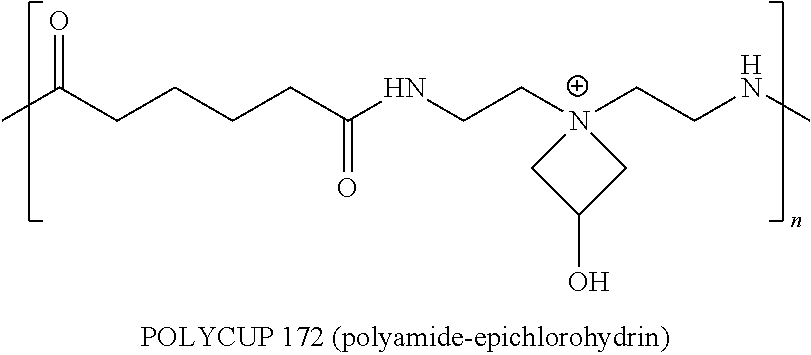Pre-treatment composition for inkjet printing
a technology of pretreatment composition and inkjet printing, applied in printing, coatings, thermal imaging, etc., can solve the problems of substantial loss of optical density, intercolor bleed, ink retransfer, etc., and achieve high pigment density and color gamut, and low grain and mottle.
- Summary
- Abstract
- Description
- Claims
- Application Information
AI Technical Summary
Benefits of technology
Problems solved by technology
Method used
Image
Examples
example 1
[0070]Treatment solutions TS-1.1 and TS-1.2 are comprised of the same components, but in different proportions. These are described in the Table 1.1 below:
[0071]
TABLE 1.1parts dry activeingredientcomponentTS-1.1TS-1.2CaCl250.042.0Z320 PVA-acac13.828.0Raycat56 latex9.212.0Polycup1723.56.0crosslinkermatte / wax4.05.0
The coating experiment outlined below examined changes in surfactant package, crosslinker level, and replacement of cross-linked methylmethacrylate polymer matte bead particles (Kodak MP1, 4 micrometer average particle size) with Lanco 1796 (Lubrizol, PTFE wax powder, 6 micrometer average particle size) on dry rub resistance. Cross-linked methylmethacrylate polymer has an estimated Rockwell hardness of R100, and PTFE has an estimated Rockwell hardness of R58, based on literature published on-line by Plastics International (http: / / www.plasticsintl.com / sortable_materials.php). The solutions were coated on Sterling Ultragloss (NewPage) offset paper using a lab-scale extrusion h...
example 2
[0074]Treatment solution TS-2 is comprised of 9.9 parts CaCl2 salt (Oxychem), 1.0 parts Catiofast159A polyamime polymer (BASF), 0.25 parts PrintRite DP376 polyurethane latex (Lubrizol), and 0.2 parts guar gum thickener (TIC Gums). This was coated at 0.65 g / m2 dry laydown on Sterling Ultragloss offset paper using a lab-scale extrusion hopper coater. The coated paper was printed and tested for dry rub as described in Example 1, and shows very poor dry rub resistance. Additional coatings were made with similar solutions that contained Lanco 1796 PTFE wax (Lubrizol, 6 micrometer average particle size) or Lanco 1799 PTFE wax (Lubrizol, 4 micrometer average particle size). The Lanco waxes were added at levels so as provide 0.01, 0.02, and 0.04 g / m2 to the dry coatings. When these coatings were printed and tested for dry rub resistance, dramatic improvements in dry rub resistance were observed for these formulations relative to the base TS-2 solution. This is summarized in the Table 2.1 be...
example 3
[0076]Treatment solution TS-3 is comprised of 50 parts CaCl2 (anhydrous, Oxychem), 22 parts Z320 modified polyvinyl alcohol (Nippon Gohsei), 9 parts Raycat56 cationic styrene-acrylic latex (Specialty Polymer, Inc.), 4.7 parts Polycup172 crosslinker (Ashland). A series of matte particles and waxes of varying composition, size, and laydown were added to TS-3 as described in the table below and coated to assess their impact on dry rub resistance. Matte particles MP1, MP2, and MP3 were made at Kodak; Lanco 1796 and Lanco 1799 were obtained from Lubrizol Advanced Materials, Inc.; CoatOSil DSA 6 was obtained from Momentive Performance Chemicals, Inc.; Hydrocerf 9174, Fluoropure Ultrafine 50CW, and nanoFlon W50C were obtained from Shamrock Technologies, Inc.; Acumist A6 was obtained from Honeywell. The sizes of the particles were measured in water / surfactant dispersions using a Horiba LA-920 particle size analyzer; the mode ESD particle size is reported. Rockwell hardness values were estim...
PUM
| Property | Measurement | Unit |
|---|---|---|
| thickness | aaaaa | aaaaa |
| equivalent spherical diameter | aaaaa | aaaaa |
| diameter | aaaaa | aaaaa |
Abstract
Description
Claims
Application Information
 Login to View More
Login to View More - R&D
- Intellectual Property
- Life Sciences
- Materials
- Tech Scout
- Unparalleled Data Quality
- Higher Quality Content
- 60% Fewer Hallucinations
Browse by: Latest US Patents, China's latest patents, Technical Efficacy Thesaurus, Application Domain, Technology Topic, Popular Technical Reports.
© 2025 PatSnap. All rights reserved.Legal|Privacy policy|Modern Slavery Act Transparency Statement|Sitemap|About US| Contact US: help@patsnap.com



